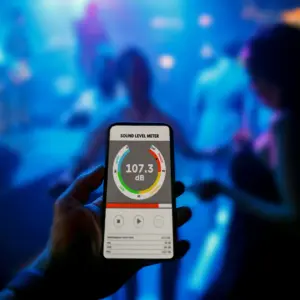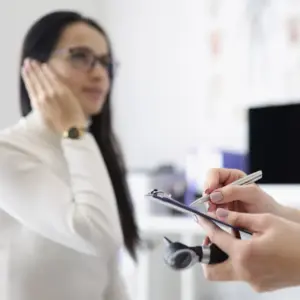Breaking the Silence: Addressing Hearing Loss in Younger Generations
For decades, the narrative around hearing loss has typically been about older people — picture grandpa struggling to catch snippets of conversation at the Thanksgiving dinner table. However, this stereotype is rapidly shifting. Today, the once-overlooked issue of hearing loss in millennials and Gen Z is resonating loudly This emerging trend dispels the longstanding myth that hearing loss is a plight reserved only for the later years of life.
Recent studies and health reports indicate a startling rise in hearing impairments among these younger cohorts. From the blaring music at concerts to the constant use of headphones, the daily auditory experiences of millennials and Gen Z are drastically different from those of previous generations. This shift in lifestyle, coupled with a lack of awareness about safe listening practices, is contributing to a growing health concern that demands attention and action.
Sounding the Alarm: Statistics and Real-Life Impacts
The Loud Facts
The numbers tell a compelling story. Research indicates that up to 17% of Gen Z and 10% of millennials are already experiencing some form of hearing loss. These figures translate into millions of young individuals who navigate daily life with muffled soundscapes. Far from being mere statistics, these numbers represent real people facing real challenges.
Beyond the Numbers
Hearing loss in younger generations isn’t just about the inability to hear; it’s about the missed opportunities and experiences. It’s about the lyrics lost in a favorite song, the whispered words in a movie missed, and the struggle to keep up in conversations, both in academic settings and professional meetings.
The impact extends beyond individual struggles to affect relationships, social interactions, and mental health. Young people with hearing loss often find themselves in a world where communication barriers lead to social withdrawal, academic underperformance, and professional setbacks. The psychological impact can be profound, manifesting in reduced self-esteem, social anxiety, and even depression.

Why the Change in Tune? Causes of Hearing Loss in Millennials and Gen Z
The Noisy World of Technology
The prevalence of personal audio devices is a significant contributor to this trend. Earbuds and headphones, used excessively at high volumes, are not mere accessories but potential sources of long-term hearing damage. This constant barrage of sound affects the delicate inner ear structures, leading to hearing impairment.
Environmental Factors
Our environments have also become louder. Concerts, sports events, and even daily city life expose the ears to noise levels that can be damaging over time. The push for louder, more immersive experiences in entertainment and social venues is taking a toll on young ears.
Medicinal Impact
Another less-discussed cause of hearing loss among millennials and Gen Z is ototoxic medications. While beneficial for treating specific conditions, certain antibiotics and pain relievers can adversely affect hearing health, contributing to the rising numbers of hearing impairment cases in these generations.
Find out more about ototoxic medications.
Understanding Safe Listening Levels
Hearing health is not just about avoiding loud noises but understanding and respecting safe listening levels. The human ear can sustain sounds below 85 decibels (dBA) without damage. However, exposure to sounds above this threshold can lead to permanent hearing loss, and the risk increases as the volume goes up.
The Role of Personal Audio Devices
Headphones and earbuds, staples for many in these younger generations, can reach volumes as high as 110 dBA. At this level, even brief exposure can be damaging. Yet, many young people use these devices for extended periods, significantly increasing their risk of hearing impairment.
Tuning In: Recognizing Early Signs of Hearing Loss in Millennials and Gen Z
Hearing loss in millennials and Gen Z often goes unnoticed until it significantly impacts daily life. Identifying the early signs can lead to timely intervention and prevent further deterioration. Here’s what to watch out for:
Subtle Indicators to Note
- Difficulty in Noisy Environments: Following conversations in noisy settings, like restaurants or social gatherings, is often one of the first signs of hearing loss in millennials and Gen Z.
- Increased Volume Needs: Regularly turning the volume on devices to levels that others find uncomfortably loud could indicate a hearing issue.
- Tinnitus: Experiencing ringing or buzzing in the ears, known as tinnitus, can be a precursor to hearing loss.
Behavioral Changes
- Social Withdrawal: Young people with emerging hearing difficulties might start avoiding social situations where listening is challenging.
- Frequent Misunderstandings: Needing things to be repeated or misunderstanding conversations can be subtle signs of hearing loss in millennials and Gen Z.
Protective Measures and Prevention
- Volume Control: Keeping the volume on personal audio devices at or below 60% can significantly reduce the risk of hearing loss in millennials and Gen Z.
- Regular Breaks: Taking breaks from continuous headphone use helps to prevent long-term auditory damage.
- Ear Protection: Using earplugs in loud environments like concerts is a simple yet effective way to protect hearing.
- Regular Hearing Screenings: Early detection is vital. Millennials and Gen Z should include hearing tests in their routine health check-ups.
- Awareness of Medication Side Effects: Being informed about ototoxic medications and seeking alternatives when possible can help preserve hearing health.
Explore more about hearing safety.
Spotlight on Modern Solutions: Addressing Hearing Loss in Millennials and Gen Z
In the face of rising cases of hearing loss in millennials and Gen Z, it’s crucial to explore contemporary solutions that cater to their unique needs and lifestyles.
Embracing Technology in Hearing Aids
Modern hearing aids are a far cry from the bulky devices of the past. Today’s aids are sleek, virtually invisible, and packed with advanced technology. They can wirelessly connect to smartphones, allowing users to stream phone calls and music directly into the aid, offering a seamless audio experience that resonates well with tech-savvy millennials and Gen Z.
Understand more about the advantages of Bluetooth hearing aids.
Apps and Digital Tools
There’s an app for almost everything, including hearing health. Millennials and Gen Z can leverage apps for hearing aid control, tinnitus management, and even auditory training. These digital tools provide convenience and empower users with greater control over their hearing experience.
Smart Home Integration
Technology is an integral part of daily life for millennials and Gen Z. Integrating hearing aids with smart home devices offers an enhanced and seamless experience. Imagine adjusting volume levels or receiving audio notifications directly through the hearing aids – these possibilities align with the tech-oriented lifestyles of these generations.

Embracing a Proactive Approach to Hearing Health
Hearing loss is no longer just an aging issue; millennials and Gen Z are increasingly affected. It’s crucial to detect hearing loss early for effective treatment and management. Today’s hearing solutions cater to the digital lifestyles of younger generations, blending style and advanced technology. This shift underscores these generations’ need for heightened awareness and proactive hearing health management. Embrace technology and prioritize hearing health to maintain the clarity of life’s soundtrack. For a hearing test and to explore modern hearing solutions, contact Stanford Hearing.
